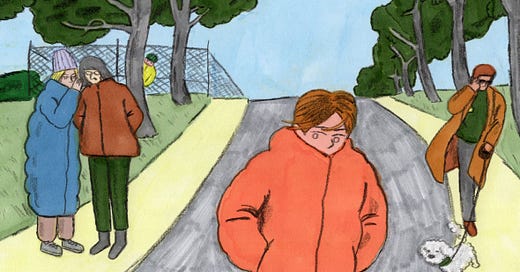Hey all,
Welcome to Human Nature, the illustrated psychology newsletter.
We have come to the end of our series on mental disorders. I hope you’ve enjoyed this series so far and found it informative. As always, please remember to look after your mental health and contact your doctor if you’re struggling.
Our topic today is schizophrenia.
Schizophrenia
What it is: Schizophrenia is a mental disorder in which the perception of reality is severely impaired. These impairments of reality, also called psychosis, can be divided into two categories: delusions and hallucinations. Delusions are beliefs that are not grounded in reality and are resistant even to concrete evidence. For example, a person with schizophrenia might believe that everyone around them is secretly conspiring against them. Hallucinations are perceptions of things that aren’t there. They can be visual or auditory, but can also consist of smells, tastes and sensations. Examples of hallucinations are hearing voices or seeing people that aren’t there.
Delusions and hallucinations constitute the positive symptoms of schizophrenia, in other words, perceptions that are in addition to what exists in reality. However, schizophrenia also involves negative symptoms, namely a in decline in the ability to feel, form and express thoughts and engage in goal-directed behaviours. Another characteristic of the condition are disorganised symptoms, such as distorted and confused thinking, speech and actions. Schizophrenia causes significant impairments in almost every aspect of the affected person’s life.
How it works: Although multiple factors contribute to the onset of schizophrenia, their existence doesn’t always guarantee the development of the disorder. Common risk factors for schizophrenia include genetics (having a parent with schizophrenia significantly increases the chances of developing it, see: Rikke et al., 2017; Verma et al. 2019) and environmental factors such as traumatic experiences and substance abuse (Howes et al. 2004).
It has been observed that there is a significant reduction in gray matter in the brains of patients with schizophrenia (Job et al., 2005). This is an important brain tissue that consists of neuronal cell bodies and dendrites, short branches that neurones use to communicate with other nearby neurones. The brain areas impaired in schizophrenia include those involved in language, emotions, thinking, movement, and the filtering or irrelevant information. There also appear to be imbalances in neurotransmitters such as dopamine and glutamate, which contribute to both positive and negative symptoms (Stepnicki, Kondej & Kaznor, 2018).
Treatment: Schizophrenia is treatable and an estimated third of patients make a full recovery, however many people don’t receive the care that they need (WHO, 2022). Antipsychotics are the most common medications used to treat schizophrenia, however they mainly target the positive symptoms and aren’t equally effective for all patients (Stepnicki et al., 2018). Pharmacological therapies appear to be more effective when combined with psychological therapies, which include: group therapy, family therapy and individual therapy (Huxley, Rendall & Sederer, 2000).
This brings us to the end of our series on mental disorders. If you have any suggestions for topics you’d like to see covered, please share them in the comments! As always, thank you for reading and see you next time.
If you are struggling with your mental health, please seek the advice or support of your GP. You can call the Samaritans 24/7 for free emotional support: 116 123. If you are having thoughts of suicide, call 999.
Sources:
Current Concepts and Treatments of Schizophrenia. (Stepnicki, Kondej & Kaznor, 2018).






If anyone wants an interesting (and moving) case study into a family's experience with schizophrenia, Hidden Valley Road by Robert Kolker is very well written and easy to follow. It corrected any misconceptions I had about the condition.
Ilac tedavisi oldugunu bilmiyordum. Epey bir insana gerek 😅. Ciddi olmak gerekirse, aramizda teshis konulmamis bir cok hasta oldugunu düşünüyorum. Devletin onleyici tip uygulamalarina akil hastaliklarini da ekleyip tarama yapmasi iyi olur. Cok hassas bir konu ve kotuye de kullanılabilir ama saglam toplum için de gerekli. Ne dersin?